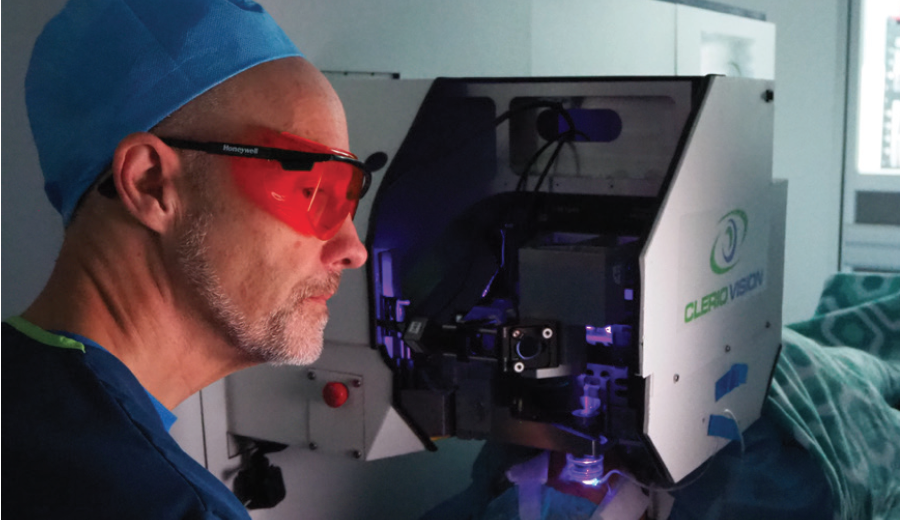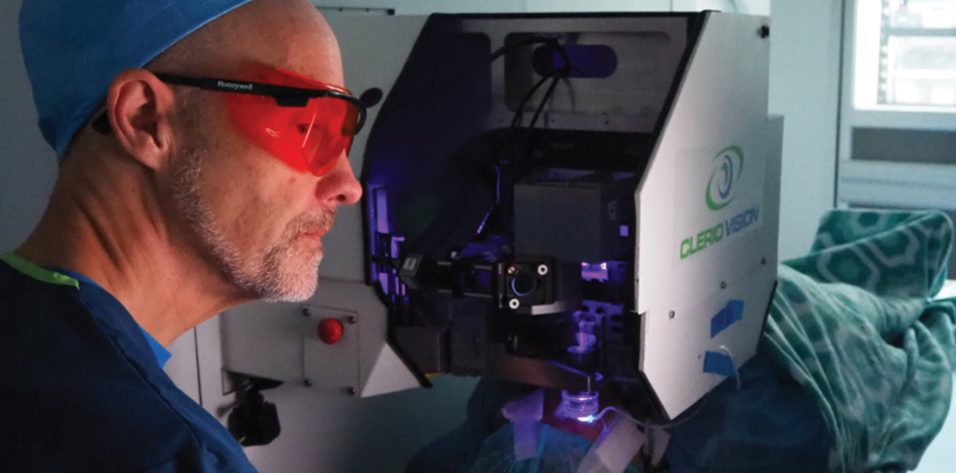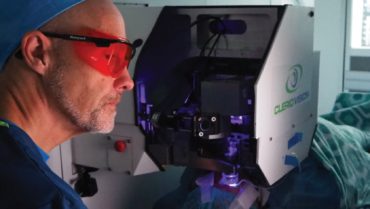
Scott M. MacRae, MD, spoke with CRST Europe about his pioneering work on laser-induced refractive index change (LIRIC), which can noninvasively alter the refractive properties of the human cornea.
CRST Europe: What is LIRIC? What technology is used to perform it?
Dr. MacRae: Clerio Vision’s LIRIC is a minimally invasive method to correct the eye’s aberrations with a laser. This is a [potential] paradigm shift in how we correct the eye’s refractive error. With all previous refractive surgery techniques, a laser such as an excimer or femtosecond is used to cut and ablate tissue. With LIRIC, a femtosecond laser is used at low energy levels, below the ablation threshold.
LIRIC is performed at a wavelength of 405 nm. At this wavelength, LIRIC is a 2-photon absorption process, resulting in highly localized refractive index changes. Within the laser focus volume (approximately 5–10 µm in diameter and length), instead of removing or disrupting tissue, we are altering collagen fibril density.1-3 LIRIC is relatively noninvasive in that we are using pulse energies that are 1/100th to 1/1,000th those used to create a femtosecond laser flap.
CRST Europe: What need is this procedure designed to meet?
Dr. MacRae: We are in the early days, and there is still a lot of work ahead of us. If LIRIC delivers on its potential, however, it will be a game changer because it is relatively noninvasive and because it could be used as first-line therapy to treat myopia, hyperopia, astigmatism, and higher-order aberrations. LIRIC expands the number of treatable patients. For example, thin corneas could be treated without the risk of inducing ectasia because the procedure does not remove any tissue. Moreover, presbyopic correction could be performed in the cornea by creating a multifocal pattern in the tissue based on diffractive designs similar to those in multifocal IOLs.
CRST Europe: Who would be a candidate for LIRIC?
Dr. MacRae: The inclusion criteria are quite broad because the procedure is so minimally invasive. Interestingly, the first LIRIC patients were older pseudophakes who had received monofocal IOLs. They recovered quickly without complications. A diffractive multifocal pattern was imparted to their corneas with LIRIC, thereby increasing their depth of focus (Figure 1).

Figure 1. OCT (left) and slit-lamp (right) images of eyes with a diffractive multifocal pattern imparted by LIRIC for presbyopic correction.
CRST Europe: What are the study results so far?
Dr. MacRae: Late in 2018, we completed our first application of LIRIC to live humans (N = 27). The results so far indicate that the multifocal LIRIC procedure for presbyopic correction imparted an approximately 1.5-line benefit to distance-corrected near visual acuity without any degradation of distance vision. Corneal thickness and curvature were unaffected. Endothelial cell density was also unaffected, suggesting a good safety profile. We recently presented some of our results at a few conferences4; however, we have not yet published human data (Figure 2).

Figure 2. Dr. MacRae performing the first-in-human LIRIC procedure.
CRST Europe: How long does the procedure take?
Dr. MacRae: Treatment time for our first-in-human presbyopia treatment was approximately 1 minute. We anticipate that treatment time will decrease to well below that as the technology matures.
CRST Europe: Is there a healing response? What postoperative management is needed?
Dr. MacRae: In our clinical and preclinical work to date, we have not seen any induced inflammation or wound-healing response. Posttreatment corneas were clear, and they [exhibited] no light scatter or signs of inflammation. Histologic studies have shown that LIRIC results in significantly less cell death than cutting a flap with a femtosecond laser.1
Our early clinical observations in humans indicate that corneas are quiet and clear right after the treatment and at 1 day, 1 week, and 1 month after treatment.
CRST Europe: Is the procedure reversible?
Dr. MacRae: Our preclinical models have shown stability out to over 2 years. Because the LIRIC pattern occupies a very thin cross section of the cornea, repeat treatments are possible at a different depth. The LIRIC treatment consists of a modified layer of stroma that is approximately 10 µm thick, which corresponds to only a small percentage of the entire cornea. We have not done reversibility studies, but we believe that the procedure is reversible.
CRST Europe: What challenges have been identified with LIRIC that must be addressed?
Dr. MacRae: The technology is still young. We’ve only just completed the first procedures in humans. We are closely tracking these patients. Although this study consisted of a multifocal treatment with 2.50 D add power, the limit to how many diopters can be imparted is yet to be seen. Contact lenses have been written up to about 10.00 D of single-vision spherical correction.
CRST Europe: How might this procedure fit with currently available options and with other adjustable options?
Dr. MacRae: The RxLAL (RxSight) is an exciting technology that increases cataract surgeons’ flexibility, but it requires having the patient avoid UV light exposure and can require repeat treatment. Moreover, the procedure is limited to a specific IOL, and the range is limited. Perfect Lens is working on modifying IOLs, and the company has reported some positive results.
LIRIC can be performed on IOLs, corneas, or contact lenses. Of these, the work on human corneas is the most exciting in my opinion. The corneal procedure promises freedom from spectacles or contact lenses. Moreover, the technology may have a much wider population of potential patients than the RxLAL or Perfect Lens system because it could treat myopia, hyperopia, astigmatism, and higher-order aberrations in pseudophakes and in nonpseudophakes. In addition, LIRIC can treat a wide variety of refractive errors without relying on a particular IOL polymer or on pupillary dilation. Again, LIRIC can be modified or repeated on multiple occasions because it changes the cornea only in a stromal layer that is 10 µm thick.
That said, LIRIC can also modify an IOL’s refractive error as a touch-up correction, which could give the surgeon more flexibility in treating postoperative refractive surprises.
CRST Europe: How could LIRIC change the surgical experience?
Dr. MacRae: There is no need for antibiotics or steroid drops because no incisions are made and the epithelium is undisturbed. Based on our animal studies, LIRIC has almost no effect on corneal nerves, making it much less likely to cause dry eye, which has been a concern with LASIK, small-incision lenticule extraction, and PRK.5
CRST Europe: What are the next steps?
Dr. MacRae: In terms of clinical development, we are targeting European approval for 2022/2023, followed by US approval. We are currently focusing on upgrading the LIRIC platform to allow a broader therapeutic range as well as additional reductions in treatment time.
CRST Europe: What future directions do you envision?
Dr. MacRae: Our goal is to develop the LIRIC technology into a first-line therapy covering all refractive corrections. This entails depositing diffractive optics into the cornea and developing other noninvasive strategies for simpler refractive corrections. If we are successful, we believe that this research will usher in a new era in ophthalmology that will allow a much larger segment of the patient population to choose noninvasive refractive surgery as their primary form of vision correction.
1. Wozniak KT, Elkins N, Brooks DR, et al. Contrasting cellular damage after Blue-IRIS and Femto-LASIK in cat cornea. Exp Eye Res. 2017;165:20-28.
2. Yu D, Brown EB, Huxlin KR, Knox WH. Tissue effects of intra-tissue refractive index shaping (IRIS): insights from two-photon autofluorescence and second harmonic generation microscopy. Biomed Opt Express. 2019;10(2):855-867.
3. Ding L, Knox WH, Bühren J, et al. Intratissue refractive index shaping (IRIS) of the cornea and lens using a low-pulse-energy femtosecond laser oscillator. Invest Ophthalmol Vis Sci. 2008;49(12):5332-5339.
4. Vukich J. Update on indexing? First in man. Paper presented at: American-European Congress of Ophthalmic Surgery Winter Symposium; February 26, 2019; Aspen, Colorado.
5. Wozniak KT, Butler SC, DeMagistris, et al. Short- and long-term impact of laser-induced refractive index change (LIRIC) on corneal nerve distribution in rabbits. Poster presented at: ARVO Annual Meeting; May 1, 2019; Vancouver, British Columbia, Canada.


